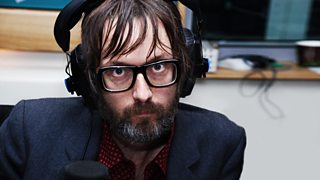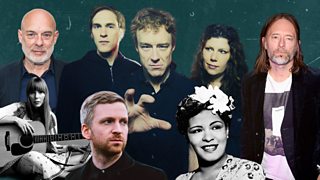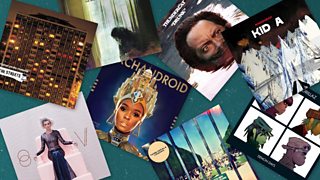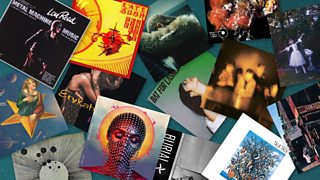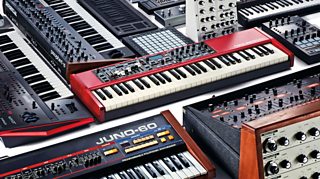Intergalactic soundtrack: 11 stellar songs inspired by space
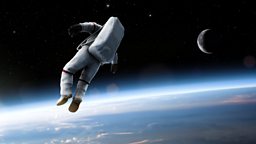
Updated 17 July 2019
To mark 50 years since the Apollo 11 moon landing, 6 Music celebrates space with a season of special shows (19-26 July).
The first human moon walk, half a century ago, has inspired countless musicians, writers and artists, and 6 Music will explore the extraordinary creative response to this historic event and the alternative story of space. You can find full details of programmes that are part of '6 Music in Space' elsewhere on this page.
Artists have long gazed at the stars to inspire their art on Earth, from Frank Sinatra’s Fly Me to the Moon right through to Elton John’s Rocket Man. That's not all either, some musicians have been taking their fascination with space to truly new heights in recent years. Metallica, Lady Gaga and Muse all want to be , while Jack White became the first person to in 2016, thanks to a custom ‘space-proof’ turntable, a high-altitude balloon and a gold plated record. Meanwhile, by Kate Tempest, Autechre and Nina Kraviz to a planet that's over 70 trillion miles away.
In honour of Apollo 11, here are our pick of 11 of the very best space-inspired songs.
1. David Bowie - Space Oddity
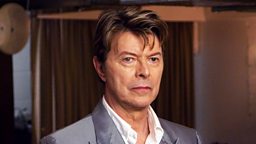
Could we begin anywhere else? He's the Starman who fell to Earth, and wrote an entire album in character as an androgynous rock star operating as an earthly messenger for aliens (1972's ...Ziggy Stardust). But perhaps most notably, David Bowie's Space Oddity, was released on 11 July 1969, nine days before Neil Armstrong took a giant leap for mankind by being the first human to step foot on the moon.
However, the song was actually informed by Bowie's fascination with space as a whole, especially influenced by Stanley Kubrick's 1968 film 2001: A Space Odyssey. "In England, it was always presumed that it was written about the space landing, because it kind of came to prominence around the same time. But it actually wasn't," he . "It was written because of going to see the film 2001, which I found amazing... it was really a revelation to me."
Despite not specifically being written for it, Space Oddity still owes much of its success to the hysteria surrounding that Apollo 11 voyage. It was even played during the TV coverage of Apollo 11 at the time despite lyrics like "Ground control to Major Tom, your circuit's dead, there's something wrong", which wouldn't have exactly instilled optimism in a generation looking to the stars.
But while the influence of our solar system on Bowie’s Space Oddity is well-known, less so is its effect on space travel itself. In 2013, Space Oddity finally reached orbit. Canadian astronaut Chris Hadfield shot to viral fame with his cover of Space Oddity aboard the International Space Station, with the song later featuring on Hadfield’s Space Stations: Songs From A Tin Can LP - the first album to be (partially) recorded in space. To accommodate a studio in the tiny vessel, Hadfield performed on a slim acoustic guitar to a tablet-attached microphone. It was worth it, as in the ultimate seal of approval Bowie himself praised Hadfield’s cover as "possibly the most poignant version of the song ever created."
2. Björk - Moon

Whether as the 17-year old singer of Icelandic punk band Tappi Tíkarrass or a vision of android intimacy in the Chris Cunningham-directed All is Full of Love video, Björk has never truly been of this world. Her muse has always been found in the dystopian and future-facing. "We are the earth intruders, We are the earth intruders," she sang on 2007's Earth Intruders, using the analogy of alien invasion to emphasis the damage we are inflicting on our own planet.
On 2011’s Moon though, Björk looked further to the night sky, finding inspiration in star constellations. The album on which it featured, Biophilia, was devised as a multimedia release that included the album itself, a three-week Manchester International Festival residency and an app that let fans interact with a three-dimensional galaxy through their phone (with David Attenborough’s soothing tones as a guide).
The song itself is full of little oddities, too. Its time signature - 17/8 with instrumental sections in 5/8 - matches the phases of the moon as four separate sequences are played by four harpists. Fittingly for a shape-shifting artist like Björk, Moon symbolises change and regeneration and how, as she once said, "with each new moon we complete a cycle and are offered renewal."
3. Brian Eno - An Ending (Ascent)

A 21-year-old Brian Eno was among the many millions of TV viewers across the world, who witnessed Neil Armstrong's first tentative steps on the moon back in 1969. As he tells 6 Music in Cox and Eno on the Moon, "I particularly remember the moon landing. I remember sitting in a friend's kitchen because he had a television, and I didn't. That evening, it was a full moon and I looked out of the window and saw the moon in the sky and thought, 'Oh, that's actually the same place. That's where this is happening. And that was a really strong moment for me of realising this wasn't fictional because it seemed like a sort of story till then."
While history was being made, Eno spotted one thing that was missing - a suitable soundtrack to match the iconic footage, rather than what he later cited in album liner notes as too much journalistic discussion which compromised the strangeness of the event.
Fast forward to the early 1980s, past Brian's string of hits as a member of Roxy Music and his eight previous solo albums, and he finally got the chance to make this happen, when, alongside his brother Roger and producer Daniel Lanois, he composed the music for 'Apollo' a documentary film about that first crewed moon landing. Originally the film was intended to simply pair footage of the Apollo 11 mission with just Eno's music. But after test screenings, it went through several revisions before finally being completed and released in 1989 under a new title 'For All Mankind', complete with additional narration and interviews.
In the meantime, Eno's accompanying soundtrack 'Apollo: Atmospheres and Soundtracks', had hit record shops six years earlier in 1983. Among the album's best known tracks are 'Deep Blue Day' which didn't make it to the final version of the documentary film (but did attract a new audience over a decade later when it was featured in the movie 'Trainspotting') and 'An Ending (Ascent)'. The latter has since been used to incredible effect in films such as '28 Days Later' and 'Traffic', and was poignantly played at the Opening Ceremony of the London Olympics in 2012, during a sequence paying tribute to the victims of the 7/7 London bombings.
This beautiful piece of music, as well as evoking endless space and a sense of calm and serenity, has been hugely influential in the ambient scene ever since. As we mark 50 years since those remarkable events on the moon, take four minutes of your time to close your eyes, picture that famous footage of Armstrong and Aldrin, and accompany it by listening to this track, a combination lost to those TV viewers back in 1969.
- The extended edition of Brian Eno's 'Apollo: Atmospheres & Soundtracks' is 6 Music's Album of the Day on Fri 19 Jul
4. Public Service Broadcasting - Gagarin

Public Service Broadcasting on The Race For Space
J. Willgoose, Esq. from Public Service Broadcasting chats about the Race For Space.
In 2015, Public Service Broadcasting - the London-based band led by frontman J. Willgoose, Esq - turned the Space Race, the battle for lunar supremacy between America and Russia during the height of the Cold War, into inspiration for a whole album, called The Race For Space.
It was a bold, audacious project, but it worked. As one critic : "To encompass such a momentous period in human history into one record – and a short one at that – may have seemed like an act of high folly but, like their forebears, Public Service Broadcasting have chosen this path not because it is easy, but because it is hard. The results are stellar."
One of the record's standout tracks, Gagarin is an ode to the first man to break beyond the Earth’s orbit, "a superhero theme for Yuri Gagarin," as Willgoose described it. Gagarin’s success at just 27 years old marked a major milestone for the Russians, and once he landed back down to Earth on 12 April, 1961 he became an instant celebrity across the globe.
The track uses broadcast recordings from the era to reflect the mood at the time, as well as our attitudes towards space and those who seek to explore it. Brimming with triumph, euphoria and optimism, Gagarin the song echoes Gagarin the man; the first ever cosmonaut.
5. Janelle Monáe - Sally Ride

Janelle Monáe's sci-fi intrigue dates back to the very beginning of her career: her 2007 debut EP Metropolis: Suite I (The Chase) was inspired by Fritz Lang's 1927 science-fiction odyssey Metropolis, a concept that continued on her breakthrough 2010 album The ArchAndroid. The latter record's cover depicted Monáe adorned by a golden, futuristic cityscape that rose from her head, mirroring Metropolis’ striking poster art that decorated movie theatres in the late 1920s.
More recently, Monáe has immortalised the space greats in her music and acting career. She played mathematician and aerospace engineer Mary Jackson in the 2017 biopic Hidden Figures, the story of NASA’s first black female mathematicians who guided America through the space race. Meanwhile, Sally Ride, from 2013’s The Electric Lady, takes its name from the first American woman to go into space. "I’m packing my space suit and I’m taking my s*** and moving to the moon," sings Monáe, using the idea of space as an escapist answer to our troubles on Earth.
6. Daft Punk - Contact

Daft Punk have long been interested in the solar system, way before they became the Pharrell-collaborating, Grammy Award-winning robot superstars of dance music that we know today. In 2003 musical film The 5tory of the 5ecret 5tar 5ystem with Interstella 5555, the duo offered up a visual representation of their second album Discovery. Working with acclaimed Japanese manga artist Leiji Matsumoto, Interstella 5555 was Daft Punk’s "animated house musical", telling the story of four alien musicians kidnapped by record executives and doomed to a life of corporate gigs and soulless pop.
The opening chimes of the animated space opera began with One More Time, a video that fused the French robots’ love of Chicago house music, golden-era funk and anime and introduced it to a new generation. Even in a post-Get Lucky world, the Romanthony-featuring record remains Daft Punk’s biggest hit, was voted the greatest dance record of all time by Mixmag in 2013 and ignited a new era of cosmic dance music known as The French Touch.
However, the duo's most purely space-themed track of their entire back-catalogue has to be Contact, the closing song from their hugely-successful 2013 album Random Access Memories. The largely-instrumental track itself sounds like an intergalactic voyage into the unknown, but it also opens with a sample of radio message from the Apollo 17 mission to the moon.
Commander Eugene Cernan speaks of a "bright object... out in the distance" that's "certainly rotating in a very rhythmic fashion, before almost thinking out loud: "I don't know whether that does you any good, but there's something out there." It's a poignant thought from the last person to ever set foot on the moon and a fitting final thought to end the album on.
7. Clint Mansell - Welcome to Lunar Industries

As one of the UK's most accomplished film composers Clint Mansell has made a name for himself in finding melody in dystopian worlds. He built the musical landscape of San Junipero, the enchanting 80s throwback episode from Charlie Brooker's anthology series Black Mirror, and in 2015’s High Rise soundtracked class warfare in a London tower block.
The former Pop Will Eat Itself singer also soundtracked Moon, the directorial debut from filmmaker Duncan Jones, son of Bowie. Nodding to the sci-fi greats Silent Running, Alien and Outland, the movie the story of one man’s solitude working on a moon base. The tale, it seems, resonated particularly strongly with Mansell. "It spoke to me so much and I really connected with it,” Mansell in 2016. “Especially on its themes of isolation and what it means to be human."
Mansell's score reflects the experience of what it must often be like to be in space alone: at times foreboding, often sombre and constantly with a sense of tension.
8. Jeff Mills - STS-47: Up Into The Beyond

The Motor City of Detroit has an unexpected affinity for alien lifeforms. The electro innovators Drexciya were obsessed with an underwater world and wrote much of their music as a soundtrack to this mythical, subterranean planet. Juan Atkins, who has been given the nickname of the 'Godfather of Techno', once said that when he first heard synthesisers it sounded like "UFOs landing", and produced a genre blueprint in 1985 with No UFOs. Then, of course, there’s Detroit techno DJ Jeff Mills, affectionately known as "The Wizard" and a key pioneer of the genre.
Mills' interest in space runs deep: he has , and even built his own known simply as 'The Visitor'. But it’s in his music where Mills' cosmic fascinations truly flourish.
2013’s Where Light Ends saw Mills collaborate with Japanese astronaut Mamoru Mohri, whose journey into space aboard the Endeavour Shuttle in 1992 formed the album’s framework. The Endeavour was unique in many ways: joining Mohri on the flight was Mae C. Jemison, the first African-American woman to fly in space and, against normal NASA policy, the first married couple to fly on the same space mission. "Where Light Ends [...] is a place of refuge, not a place where life may not exist," Mills remarked in 2013.
9. Hannah Peel - Andromeda M31

Ask any musician and they’ll probably hold their own unique interpretation of what space sounds like. To George Clinton, it’s perhaps an alien playing p-funk on a six-stringed bass. For Delia Derbyshire, the pioneering composer who co-wrote Doctor Who’s theme tune, the cosmos was found in early sound generating equipment such as the wobulator and valve oscillators.
Trading wobulators for Juno synthesisers, Derbyshire proved a key inspiration in Hannah Peel’s Andromeda M31. Named after the Andromeda Galaxy (or Messier 31) found 2.5 million light-years from Earth, the song was one chapter in the tale of Mary Casio. Dreamed up by Peel for her 2017 album Mary Casio: Journey to Cassiopeia, Mary Casio is a fictional elderly woman from Yorkshire who sets sail across the solar system and beyond.
Peel continued the theme on this year's Particles In Space, which sees the Northern Irish musician and a handful of special guest collaborators mixing a colliery brass band and synthesisers. Just like space exploration, it sounds like the collision of two worlds.
10. Sun Ra - Space Is The Place
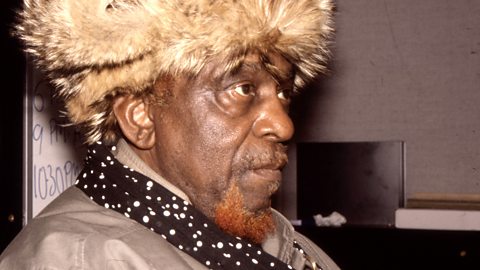
Sun Ra imagines performing on Mars
Sun Ra tells Jez Nelson his music is for beings on earth and beyond.
The birth certificate of spiritual-jazz godfather Sun Ra may say that he was born Herman Poole Blount in Birmingham, Alabama during 1914, but believe the word of Blount himself and you’ll know that Sun Ra is actually an alien sent to Earth from the planet Saturn as a miniMOOG-playing peace preacher.
"The trouble with the people on this planet is they refuse to think," wrote the man himself in Prophetika, a collection of formerly unpublished poems that became Sun Ra’s foreshadowing of Earth’s end-times. "They refuse to believe anything except what they know."
Sun Ra's music and mythical beliefs made him a founding father of Afrofuturism, and 1973’s Space Is The Place is his most spaced-out track. Even within the avant-garde and experimental jazz circles, this 21-minute epic, with its shrieking saxophone melodies and free-forming be-bop, was something out of this world.
Find out more about Sun Ra in the Radio 4 documentary Travelling the Spaceways: The Cult of Sun Ra.
11. Beastie Boys - Intergalactic
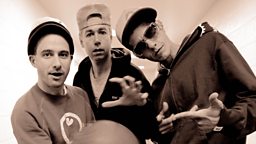
Beastie Boys have always pulled from far and wide for their lyrical inspiration - who else can boast to be "like Einstein and the Rapping Duke combined", as heard on ‘Ch-Check It Out’? 1998’s ‘Intergalactic’ was no different: mixing Japanese TV influences in its video with the song's vague space theme, as the group use the chorus of "Intergalactic, planetary, planetary, intergalactic. Another dimension, another dimension" to boast about their rapping prowess.
The of the track contained many more space references than the eventually released version too, with its lyrics making nods to the Great Gazoo (the green alien from The Flintstones), Neil Armstrong playing golf on the moon and "space fornication".
The three Beasties - Ad-Rock, Mike D and the late MCA - performed Intergalactic as animated heads in glass jars on the TV series Futurama, while its iconic line "like a pinch on the neck from Mr Spock" has even inspired its own , one where MCA inadvertently invented the Vulcan nerve pinch 260 or so years before it became Mr Spock’s signature fighting move.
Words by Jack Needham (except Brian Eno - words by Ian Sadler)
Follow us on , on Twitter , or on Instagram .
6 Music in Space: What's On?
-
![]()
Shaun Keaveny, Live from the Bluedot Festival at Jodrell Bank
Available from Fri 19 Jul, 1pm
-
![]()
Jarvis Cocker’s Giant Leap
Available from Fri 19 Jul, 7pm
-
![]()
Radcliffe and Maconie Live from the Bluedot Festival at Jodrell Bank
Available from Sat 20 Jul, 1pm
-
![]()
Tracking the Space Race - How Jodrell Bank revealed the true tale of the race to the moon
Available from Sun 21 Jul, 1am
-
![]()
Eno and Cox on the Moon
Available from Sun 21 Jul, 1pm
-
![]()
Now Playing: Space Special - with guest curator Chris Linott from Sky At Night
Available from Sun 21 Jul, 6pm


